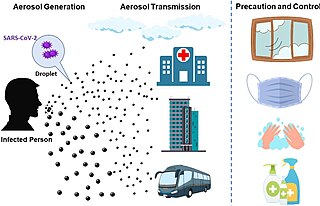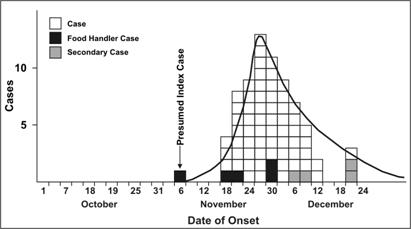
An epidemic is the rapid spread of disease to a large number of people in a given population within a short period of time. For example, in meningococcal infections, an attack rate in excess of 15 cases per 100,000 people for two consecutive weeks is considered an epidemic.

Incubation period is the time elapsed between exposure to a pathogenic organism, a chemical, or radiation, and when symptoms and signs are first apparent. In a typical infectious disease, the incubation period signifies the period taken by the multiplying organism to reach a threshold necessary to produce symptoms in the host.

Severe acute respiratory syndrome (SARS) is a viral respiratory disease of zoonotic origin caused by severe acute respiratory syndrome coronavirus, the first identified strain of the SARS coronavirus species severe acute respiratory syndrome–related coronavirus (SARSr-CoV). The syndrome caused the 2002–2004 SARS outbreak. Around late 2017, Chinese scientists traced the virus through the intermediary of Asian palm civets to cave-dwelling horseshoe bats in Xiyang Yi Ethnic Township, Yunnan.
The science of epidemiology has matured significantly from the times of Hippocrates, Semmelweis and John Snow. The techniques for gathering and analyzing epidemiological data vary depending on the type of disease being monitored but each study will have overarching similarities.

In epidemiology, an outbreak is a sudden increase in occurrences of a disease when cases are in excess of normal expectancy for the location or season. It may affect a small and localized group or impact upon thousands of people across an entire continent. The number of cases varies according to the disease-causing agent, and the size and type of previous and existing exposure to the agent. Outbreaks include epidemics, which term is normally only used for infectious diseases, as well as diseases with an environmental origin, such as a water or foodborne disease. They may affect a region in a country or a group of countries. Pandemics are near-global disease outbreaks when multiple countries across the world are infected.

Chikungunya is an infection caused by the Chikungunya virus (CHIKV). Symptoms include fever and joint pains. These typically occur two to twelve days after exposure. Other symptoms may include headache, muscle pain, joint swelling, and a rash. Symptoms usually improve within a week; however, occasionally the joint pain may last for months or years. The risk of death is around 1 in 1,000. The very young, old, and those with other health problems are at risk of more severe disease.
In epizoology, an epizootic is a disease event in a nonhuman animal population analogous to an epidemic in humans. An epizootic may be restricted to a specific locale, general, or widespread ("panzootic"). High population density is a major contributing factor to epizootics. Aquaculture is an industry sometimes plagued by disease because of the large number of fish confined to a small area.

The Epidemic Intelligence Service (EIS) is a program of the U.S. Centers for Disease Control and Prevention (CDC). The modern EIS is a two-year, hands-on post-doctoral training program in epidemiology, with a focus on field work.

Oropouche fever is a tropical viral infection transmitted by biting midges and mosquitoes from the blood of sloths to humans. This disease is named after the region where it was first discovered and isolated at the Trinidad Regional Virus Laboratory in 1955 by the Oropouche River in Trinidad and Tobago. Oropouche fever is caused by a specific arbovirus, the Oropouche virus (OROV), of the Bunyaviridae family.
The index case or patient zero is the first documented patient in a disease epidemic within a population, or the first documented patient included in an epidemiological study. It can also refer to the first case of a condition or syndrome to be described in the medical literature, whether or not the patient is thought to be the first person affected. An index case can achieve the status of a "classic" case study in the literature, as did Phineas Gage, the first known person to exhibit a definitive personality change as a result of a brain injury.
Globalization, the flow of information, goods, capital, and people across political and geographic boundaries, allows infectious diseases to rapidly spread around the world, while also allowing the alleviation of factors such as hunger and poverty, which are key determinants of global health. The spread of diseases across wide geographic scales has increased through history. Early diseases that spread from Asia to Europe were bubonic plague, influenza of various types, and similar infectious diseases.
Robert V. Tauxe is the Director of the Division of Foodborne, Waterborne and Environmental Diseases of the Centers for Disease Control and Prevention.
Rocio viral encephalitis is an epidemic flaviviral disease of humans first observed in São Paulo State, Brazil, in 1975. Low-level enzootic transmission is likely continuing in the epidemic zone, and with increased deforestation and population expansion, additional epidemics caused by Rocio virus are highly probable. If migratory species of birds are, or become involved in, the virus transmission cycle, the competency of a wide variety of mosquito species for transmitting Rocio virus experimentally suggest that the virus may become more widely distributed. The encephalitis outbreak in the western hemisphere caused by West Nile virus, a related flavivirus, highlights the potential for arboviruses to cause severe problems far from their source enzootic foci.

Coronavirus disease 2019 (COVID-19) is a contagious disease caused by severe acute respiratory syndrome coronavirus 2 (SARS-CoV-2). The first known case was identified in Wuhan, China, in December 2019. The disease has since spread worldwide, leading to an ongoing pandemic.

COVID-19 surveillance involves monitoring the spread of the coronavirus disease in order to establish the patterns of disease progression. The World Health Organization (WHO) recommends active surveillance, with focus of case finding, testing and contact tracing in all transmission scenarios. COVID-19 surveillance is expected to monitor epidemiological trends, rapidly detect new cases, and based on this information, provide epidemiological information to conduct risk assessment and guide disease preparedness.
Cécile Viboud is a Staff Scientist based in the Fogarty International Center at the National Institutes of Health, where she is part of the Multinational Influenza Seasonal Mortality Study (MISMS). Viboud specialises in the mortality of infectious disease. Viboud was involved with epidemiological analysis during the COVID-19 pandemic.
The Central Epidemic Command Center is an agency of the National Health Command Center (NHCC). It has been activated by the government of Taiwan for several disease outbreaks, such as the 2009 swine flu pandemic and the COVID-19 pandemic. The head of the agency is Chen Shih-chung, the minister of Health and Welfare. The CECC is associated with the Taiwan Centers for Disease Control.
In epidemiology, particularly in the discussion of infectious disease dynamics (modeling), the latent period is the time interval between when an individual or host is infected by a pathogen and when he or she becomes infectious, i.e. capable of transmitting pathogens to other susceptible individuals.

The transmission of COVID-19 is the passing of coronavirus disease 2019 from person to person. The disease is mainly transmitted via the respiratory route when people inhale droplets and particles that infected people release as they breathe, talk, cough, sneeze, or sing. Infected people are more likely to transmit COVID-19 when they are physically close to others. However, infection can occur over longer distances, particularly indoors.
In epidemiology, sporadic is a term used to refer to a disease which occurs only infrequently, haphazardly, irregularly or occasionally from time to time in a few isolated places with no discernible temporal or spatial pattern, as opposed to a recognizable epidemic or endemic pattern. The cases are so few and separated so widely in time and place that there exists little or no connection within them. They also do not show a recognizable common source of infection.










